M oO3-C3N4复合光催化剂的可见光下高效催化降解甲基橙
2018-10-12马令娟侯梦宁马宏彬陆玥汝
马令娟 侯梦宁 马宏彬 曹 震 薛 振 陆玥汝
(曲阜师范大学化学与化工学院,曲阜 273165)
0 Introduction
With the rapid growth and development of the world economy,an increasing number of people recognize the importance of the threat of water pollution,which results from industrial and mining activities.Water pollution has increased people concerns about its negative consequences for health and public safety as well as its impact on environment.Over the past decades,as far as control and increasing regulation over contaminants,a wide range ofmethods including chemical precipitation,biological treatment,adsorption and photocatalysts have been proposed for wastewater treatment[1-4].However,several drawbacks are needed to overcome:biological processes are not efficient for degrading complex and biorecalcitrant contaminants,while chemical precipitation is severely affected by pH and complexing agent.Additionally,expensive regeneration of adsorbents restricts the development of adsorption processes[2,5-7].On the contrary,semiconductor photocatalysts have been proposed to degrade and remove contaminants from wastewater due to their high efficiency,nontoxic and feasibility with sunlight[8-10].Among various developed semiconductor photocatalysts,TiO2is one of the most widely used photocatalyst for water remediation because of nontoxicity,low processing cost and high stability in aqueousmedium[11-14].However,TiO2has several disadvantages such as that it only absorbs UV photons as it has a large band gap about 3.2 eV,and it has a short lifetime of the photo-generated electronhole pairs[15-16].Therefore,to overcome such drawbacks and increase photocatalytic activity,researches have focused on doping TiO2surface with metals or nonmetal ions,combination with other semiconductors or development of non-TiO2based and novel photocatalyticmaterials[17-19].
Recently,Wang et al.first used metal-free polymeric graphite-like carbon nitride (g-C3N4)as photocatalyst,which exhibits high photocatalytic performance for hydrogen generation[20].C3N4photocatalyst can be prepared by directly heating N-rich precursors(such asmelamine,urea)at different temperature and heating rate[21-23].Although g-C3N4has been regarded as attractive photocatalyst due to its unique properties,such as facile preparation,low processing cost,moderate band gap and high chemical stability,the poor absorptivity and low electron mobility rate restrict the developmentofg-C3N4[24-26].Therefore,among the various strategies for improving photocatalytic performance of g-C3N4,its combination with transition metal oxides is a feasible one[27-29].For example,Zhang et al.synthesized g-C3N4/TiO2(B)nanofibers with exposed (001)plane and the composites exhibited enhanced visible-lightactivity[30].Hu etal.reported Fe3+doped g-C3N4and Fe2O3/g-C3N4catalystsusingmelamine and ferric nitrate as precursors[31]. C3N4/CoO was designed and fabricated for the first time and exhibit more-efficient utilization of solar energy than pure g-C3N4[27].Furthermore,it was found that MoO3has a band gap of 2.8~3.2 eV and can be active in both UV and visible light[32].Cu0.33MoO3nanorod was synthesized via hydrothermal route and used for degradation of toluidine blue“O”and chlorobenzene[33].MoO3/polymer polyimidewas synthesized via an in situ crystal growth approach,the obtained composite exhibits enhanced photocatalytic activity for H2evolution[34].Li et al.prepared MoO3-g-C3N4which show high efficiency for the degradation ofmethylene blue[32].He etal.prepared MoO3-g-C3N4composites exhibiting higher activity than pure g-C3N4,which is attributed to the strong and wide adsorption of visible light and high separation of photogenerated electron-hole pairs[35].Although MoO3-C3N4composite catalyst has better catalytic activity under visible light irradiation,there are few reports about the photocatalytic mechanism over MoO3-C3N4composites prepared by differentmethods.
In thiswork,a series of MoO3-C3N4photocatalysts were successfully synthesized by impregnation method using(NH4)6Mo7O24·4H2O and C3N4as precursors.The microstructure and photocatalytic efficiency of MoO3-C3N4under visible lightwere investigated.Particularly,1.60%(w/w)MoO3-C3N4catalysts exhibited high photocatalytic activity in the degradation of MO under visible light irradiation.The synergic effect between MoO3and C3N4and the possible mechanisms of enhancement of photoactivity were also investigated.
1 Experimental
1.1 Preparation of the catalysts
Pure C3N4powder was prepared by directly heatingmelamine at 500℃for 4 h with a heating rate of 2.5℃·min-1in air.
The MoO3-C3N4photocatalysts were synthesized by impregnation method.In a typical synthesis,the desired amount(NH4)6Mo7O24·4H2O(0.003~0.094 g)was dissolved in 0.7 mL of deionized water.Subsequently,the solution was added drop-wise to C3N4powder in a porcelain crucible under stirring and then dried at 80℃for 6 h.Finally,the obtained powder was calcined at 500℃for 2 h.The final products were denoted as x%MoO3-C3N4,where x%is themass fraction of MoO3.
Selective deposition of noble metal Pt was performed.50 mg of 1.60%MoO3-C3N4catalyst was dispersed in 80mL of 15%(V/V)lactic acid solution and ultrasonically dispersed for 5 min.Then,300μL of 0.02 g·mL-1H2PtCl6aqueous solution was added to the suspension and ultrasonically dispersed for 3 min.Finally,a 300W xenon lamp was used as light source and themixturewas irradiated for 0.5 h under stirring.
1.2 Characterization methods
XRDmeasurementswere recorded on a RigakuD/MAXRB diffractometer with Cu Kα radiation(λ=0.154 18 nm)within the range of 2θ=10°~70°at a voltage of 40 kV and a current of 300 mA.HR-TEM images were obtained on a JEM-2100 PLUS transmission electron microscope at an accelerating voltage of 200 kV.Fourier transform infrared (FT-IR)spectra of the catalysts were recorded on a Nicolet Nexus-670 spectrometer.The specific surface area and pore size of the samples were measured by a SSA-4200 pore size specific surface area analyzer (Beijing builder electronic technology).Ultraviolet visible(UV-Vis)diffuse reflection spectra were measured using a UVVis spectrophotometer (Shimadzu UV 3600,Japan)within the range of 200~800 nm.X-ray photoemission spectroscopy (XPS)was measured in a PHI5300 ESCA system.The beam voltage was 3.0 eV,and the energy of Ar ion beam was 1.0 keV.The binding energieswere normalized to the signal for adventitious carbon at 284.8 eV.
1.3 Evaluation of the photocatalytic activity
The photocatalytic activity of MoO3-C3N4nanocomposites was evaluated by degradation of MO(10 mg·L-1)aqueous solution in a quartz glass reactor under visible light irradiation.Before irradiation,40 mg ofMoO3-C3N4sampleswere ultrasonically dispersed in 80 mL MO solution for 10 min and the suspension was stirred in the dark for 30 min to establish an adsorption-desorption equilibrium.The visible light used for photocatalytic degradation was generated with a CEL-HXUV 300 Xe lamp coupled with UV cutoff filter (λ>420 nm,Zhongjiao Jinyuan Technology).During the photocatalytic reaction,the reaction system was magnetically stirred and 5 mL liquids were collected at specific reaction time.Then,the collected sampleswere centrifuged.Finally,the concentration of catalyst-free MO solution was analyzed by recording variations of the absorbance maximum (λ=463 nm)using a 754PCUV/Visible spectrophotometer(Shanghai Jinghua Group Corporation).As a comparison,photocatalytic degradations of MO in the presence of MoO3or C3N4were also performed under visible light irradiation.
Hole and free radical trapping experiment was similar to the photocatalytic degradation experiment.1,4-benzoquinone (BQ,·O2-scavenger),tert-butyl alcohol(TBA,·OH scavenger)or ammonium oxalate(AO,h+scavenger)were added to MO(10mg·L-1)aqueous solution with 40 mg of 1.60%MoO3-C3N4photocatalyst before ultrasound[36].
2 Results and discussion
2.1 Structure of the photocatalysts
The XRD patterns of MoO3,C3N4and x%MoO3-C3N4composites are shown in Fig.1.It can be seen that all the diffraction peaks of pure MoO3can be indexed as the orthorhombic structure (PDF No.99-0080).The main peaks at 12.77°,23.33°,25.65°,27.33°and 39.04°correspond to the (020),(110),(040),(021)and(060)planes,respectively[37].Pure g-C3N4exhibited two diffraction peaks at 13.11°and 27.43°,corresponding to the in-plane repeated units of(100)and the inter-layer structural packing of(002)planes,respectively[38].g-C3N4can be detected in all MoO3-C3N4composites.However,diffraction peaks of MoO3were not observed in samples of 0.16%~0.80%MoO3-C3N4composites,which should be due to the low content of MoO3and homogeneously dispersion in composites.Further increasing the contents of MoO3to 1.6%and 5.0%,the MoO3phase can be detected by XRD.The diffraction peaks of g-C3N4phase were gradually weakened with the introduction of MoO3,may be attributed to the reduced crystallinity of g-C3N4.Interestingly,the diffraction peaks of the(002)plane of g-C3N4in MoO3-C3N4composites shifted to a higher 2θvalue by about 0.45°compared to pure g-C3N4,indicating the decreased interlayer distance of C3N4[38].

Fig.1 XRD patterns ofMoO3,C3N4 and x%MoO3-C3N4
Themorphology and structure of pure g-C3N4and 1.60%MoO3-C3N4were also characterized by TEM.As shown in Fig.2a,pure g-C3N4exhibits typical twodimensional lamellar structure.The TEM image of 1.60%MoO3-C3N4(Fig.2b)displays that the surfaces ofMoO3nanoparticleswere coated with thin amorphous layers of C3N4,leading to the formation of MoO3-C3N4heterostructure.This hybrid structure will decrease the recombination rate of photogenerated electron-hole pairs as well as prolong lifetime of charge carriers during the photocatalytic reaction.Moreover,EDS(Fig.2c)exhibited that the selected areas of the sample are composed with Mo,O,C and N elements.More detailed structural characteristics for 1.60%MoO3-C3N4were studied by HR-TEM as shown in Fig.2d.The fringes with an interplanar spacing of about 0.350 nm correspond to (040)crystal plane of MoO3,which is in consistent with the XRD patterns.In addition,another phase without fringes can be assigned to C3N4.
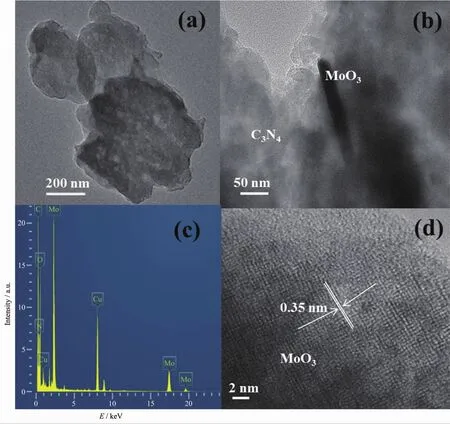
Fig.2 TEM images of C3N4(a)and 1.60%MoO3-C3N4(b);EDS spectrum of 1.60%MoO3-C3N4(c)and HRTEM image of 1.60%MoO3-C3N4 photocatalyst(d)
Fig.3 shows the FT-IR spectra of MoO3,C3N4and MoO3-C3N4heterojunctions with different MoO3contents.For the pure C3N4,the peaks at 1 242~1 636 cm-1are assigned to typical CN heterocycle stretching vibration modes,while the sharp peak located at 810 cm-1is related to the characteristic vibrational mode of triazine units[38].The peaks observed at 993 cm-1corresponds to Mo=O stretching mode.The peaks at 562 and 867 cm-1are ascribed to the stretchingmode of oxygen linked with threemetal atoms in the Mo-OMo units,respectively[39].Themain characteristic peaks of C3N4appeared in all MoO3-C3N4photocatalysts.The infrared-active modes of MoO3were not detected in 0.16%~1.6%MoO3-C3N4composites due to the low concentration of MoO3,which is in consistent with XRD patterns.
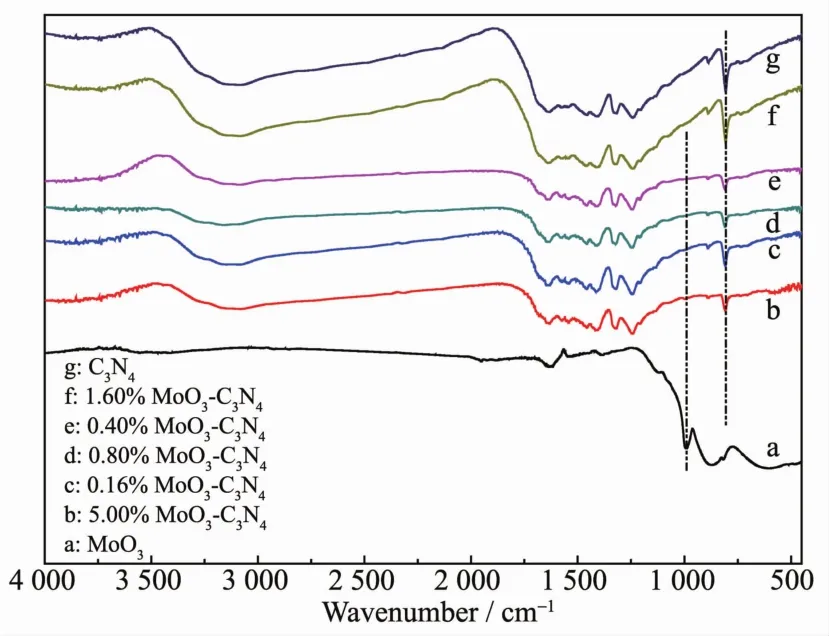
Fig.3 FT-IR spectra of synthesized MoO3,C3N4 and x%MoO3-C3N4
XPSmeasurements were performed to determine the valence states of various species.Fig.4 shows the XPS spectra of MoO3,g-C3N4and 1.6%MoO3-C3N4.C1s high resolution XPS spectra are shown in Fig.4A and it was found that pure g-C3N4has two C1s peaks centered at 284.8 and 288.3 eV which could be attributed to adventitious carbon on the surface and N-C-N coordination in graphitic carbon nitride,respectively[40-41].The N1s binding energy of pure g-C3N4was observed at 398.6 eV,which can be assigned to the presence of sp2-bonded graphitic carbon nitride[42].The observed slight shift of N1s peak (398.4 eV)in 1.6%Mo-C3N4composite can be attributed to the interaction between Mo and N atoms.MoO3has a strong O1s peak at 531.2 eV which could be attributed to the O2-species in molybdenum oxide,while pure g-C3N4has a low intensity O1s peak produced by adsorbed H2O.The O1s peak of 1.6%Mo-C3N4composite can be thought to be the overlap of the two oxygen species.The Mo3d5/2(233.2 eV)and the Mo3d3/2peaks of pure MoO3showed that only Mo6+species are detected;while,the Mo3d peaks of 1.6%Mo-C3N4composite shift to 232.3 and 235.5 eV,which could be attributed to the existence of both Mo5+and Mo6+species on the surface[43].
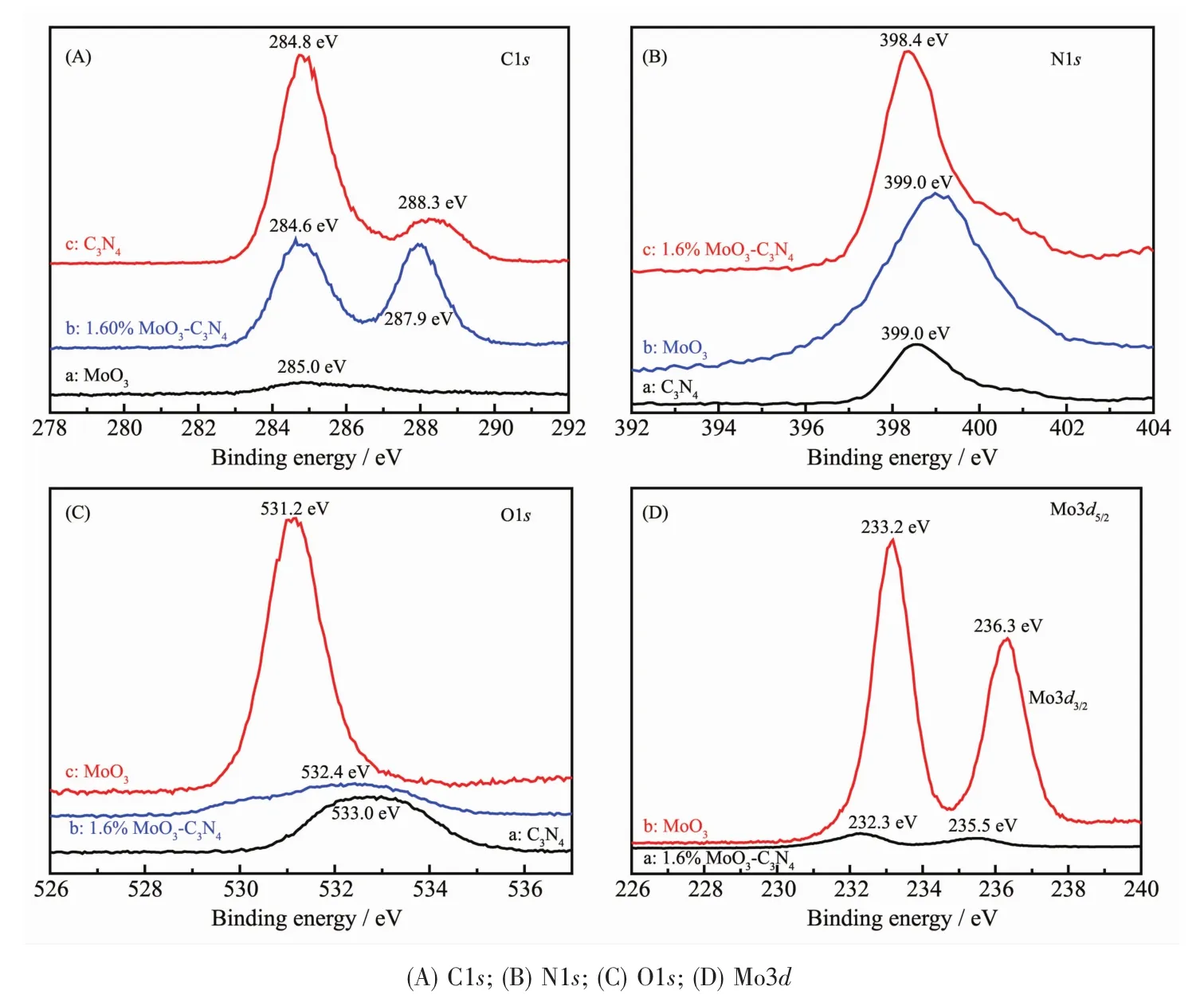
Fig.4 XPS spectra ofMoO3,C3N4 and 1.60%MoO3-C3N4 composite
The UV-Vis DRS spectra of MoO3,C3N4,1.60%MoO3-C3N4and 5.00%MoO3-C3N4compositesare shown in Fig.5.As can be seen in Fig.5A,MoO3and g-C3N4had absorption edge at approximate 440 and 470 nm,respectively.The absorption edge of MoO3-C3N4composite isweaker than that of pure g-C3N4while the absorbance of composite is obviously higher than pure g-C3N4.Opticalband gaps(Eg)were obtained via Taucplots,amethod invented by the physicist[44].The band gap energy of a semiconductor can be estimated by the following: αhν=A(hν-Eg)n/2,where α,h,ν,A and Egare the adsorption coefficient,Planck constant,light frequency,a proportionality constant and band gap energy,respectively.Considering that MoO3and C3N4are direct transition and indirect transition semiconductors,respectively,for MoO3and C3N4,the values of n are 1 and 4,respectively[39,45].The Egcan be obtained from the plot of(αhν)2/nversus hν,by extrapolation of the linear part near the onset of the absorption edge to intersect the energy axis.As shown in Fig.5B,the Egof MoO3was 2.86 eV according to a plot of(αhν)2versus energy(hν)and the Egof C3N4was estimated to be 2.60 eV according to a plot of(αhν)1/2versus energy(hν).The valence bands(VB)of MoO3and C3N4are shown in Fig.6.The position of the VB edges of MoO3and C3N4were 3.28 and 1.58 eV,respectively.

Fig.5 UV-Vis spectra ofMoO3,C3N4,1.60%MoO3-C3N4 and 5.00%MoO3-C3N4 composites(A)and the estimated band gaps ofMoO3 and C3N4(B)

Fig.6 Valence band XPSofMoO3 and C3N4
Generally,the ability of adsorption,desorption and diffusion of reactants and products are mainly determined by the SBETand pore volume of the catalyst.Therefore,a catalyst with high specific surface area (SBET)and big pore volume is significant to the enhancement of catalytic performance.The surface area and pore volume of the prepared samples were obtained from N2adsorption-desorption isotherms.As shown in Fig.7,all samples except MoO3exhibit a typeⅣisotherm with H3 hysteresis loop,suggesting the presence of mesopores. The high-pressure hysteresis loop(0.9<P/P0<1)is related to the larger pores formed between secondary particles,suggesting the presence of lamellar pore structures.MoO3shows a typeⅢisotherm without hysteresis loop,which means MoO3sample do not have pore structure.As listed in Table 1,pure MoO3and g-C3N4show relatively low specific surface area (7 and 8 m2·g-1,respectively).Compared with pure phases,all MoO3-C3N4composites exhibit high BET surface areas,which might be attributed to thermal exfoliation of g-C3N4into thinner nanosheets during compositing process.With increase of the MoO3concentration,BET surface areas of samples increased from 8 to 131 m2·g-1until the content reached 1.60%.While further increasing of MoO3content to 5% will induce dramatic reduction of BET surface area,whichmay be due to that MoO3can promote the combustion of g-C3N4.The pore volume of samples showed a similar change tendency and 1.60%MoO3-C3N4catalyst has the highest pore volume which was 0.893 mL·g-1.1.60%MoO3-C3N4catalyst shows the highest specific surface area and pore volume.
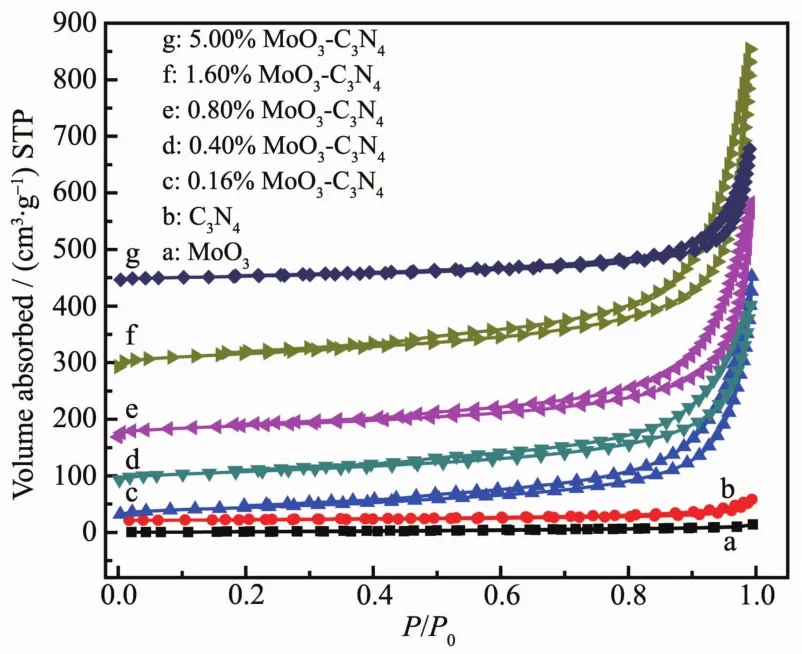
Fig.7 Nitrogen adsorption-desorption isotherms of the samples

Table 1 Specific surface areas and pore volumes of the sam ples
2.2 Photocatalytic test
For evaluation of photocatalytic performances of MoO3,pure C3N4and MoO3-C3N4composites,asprepared materials were used for degradation of MO under visible-light irradiation.As illustrated in Fig.8A,under visible light irradiation,the self-degradation of MO is negligible in the absence of catalyst,indicating that the photolysis could be ignored.In the presence of pure MoO3or C3N4catalysts,5%or 17%of MO was degraded under visible-light irradiation in 120 min,respectively.However,obvious degradation of MO was observed in the presence of the composition catalysts.When the proportion ofMoO3reached 1.60%,the as-prepared photocatalyst exhibited highest photocatalytic activity,reaching 100%MO conversion.The photocatalytic activity began to decreasewhen the content of MoO3was higher than 1.60%.So,it can be concluded that the effective degradation of MO occurs when MoO3-C3N4composites take part in the photocatalytic reaction and the 1.6% MoO3-C3N4sample displayed the highest photocatalytic activity of degradation of MO under visible-light.It has been discussed that 1.6%MoO3-C3N4photocatalyst has the highest BET surface area and pore volume,so the surface area and pore volume must be one of the reasons why 1.6%MoO3-C3N4photocatalyst showed the highest photocatalytic activity.High surface area will increase the number of surface active sites and diffusion of the MO toward the active sites.Additionally,this increased photocatalytic performance should be ascribed to the effective separation of electrons holes pairs and transfer of photogenerated charges[35,39].
It can be found that with the presence of photocatalysts the degradation data of MO showed exponential relationship with irradiation time,suggesting the reaction follows a first order kinetics.Thus the rate was based on performance equation which could bewritten as follow[46]:


Fig.8 Photocatalytic degradation ofMO over MoO3,C3N4 and MoO3-C3N4 under visible light irradiation(A)and the corresponding kinetic studies(B)
Where C0is the concentration of MO after adsorptiondesorption equilibrium,Ctrepresents the concentration of remaining MO after photocatalytic degradation at irradiation time(t)and k is the corresponding rate constant.So,the degradation rate constant of MoO3,C3N4and a series of MoO3-C3N4photocatalysts(Fig.8B)can be obtained according to linear fit of plot of ln(C0/Ct)vs t,respectively.The k of pure g-C3N4is 0.001 9 min-1.While,the rate constant of 1.60%MoO3-C3N4photocatalyst is up to 50 times higher than that of pure g-C3N4.In other words,the prepared MoO3-C3N4heterostructure is much more effective than g-C3N4and there is an optimum content of MoO3to obtain an active heterostructure for degradation ofmethyl orange under visible light.
As shown in Fig.9,the photocatalytic degradation efficiency over the prepared MoO3-C3N4samples depended on the MoO3content under visible-light irradiation of 40 min.Increasing the content of MoO3within the range of 0 to 1.60%,the degradation efficiency of MO on MoO3-C3N4composites increased rapidly,while the degradation efficiency began to decrease when the content of MoO3was higher than 1.6%.The possible reason might be excessive MoO3can cause aggregation of C3N4,so the BET surface area started to decrease when content of MoO3is higher than 1.60%.Therefore,1.60%is a suitable content of MoO3in the MO photocatalytic degradation.

Fig.9 Degradation efficiency changes ofMO with the contentof MoO3 in the presence ofMoO3-C3N4 composites at themomentof visible-light irradiation of 40min
The influence of the initial MO concentration for degradation of MO over 1.60% MoO3-C3N4under visible-light irradiation was also studied as shown in Fig.10a.The degradation efficiency decreased with the increase of initial MO concentration,which might be ascribed to the light screening effect in high concentration of MO solution.The influence of different dyes was also investigated and the results are shown in Fig.10b.Actually,the MoO3-C3N4photocatalysts prepared by impregnation method exhibited high photoactivity for degradation of MO,rhodamine B (RhB)and methylene blue (MB)dyes,indicating the synthesized MoO3-C3N4composite is a universal photocatalyst for degradation of organic dyes.

Fig.10 Influence of initial MO concentration(a)and different dyes for degradation(b)
To investigate the catalytic stability of MoO3-C3N4heterojunctions,the photocatalytic performance of 1.60%MoO3-C3N4was investigated in three cycles.As shown in Fig.11,the degradation efficiency of 1.60%MoO3-C3N4photocatalyst decreased gradually with the increase of cyclic times,which might be due to the solubility of MoO3during water purification.

Fig.11 Catalytic stability test of 1.6%MoO3-C3N4 composite
2.3 Possiblemechanism of M oO3-C3N4 com posite
Fig.12 shows the kinetic constants of MoO3-C3N4photocatalyst in the presence of different quenchers.After adding TBA to the reaction system,the constant rate was decreased a little,indicating that·OH was not the dominant active species.In contrast,the degradation rate declined sharply after addition of BQ or AO,indicating that both·O2-and h+are mainly responsible in the hole and free radical trapping experiment,as BQ and AQ are·O2-and h+scavenger,respectively.
The bottom energy of the conduction band(CB)positions of C3N4and MoO3were calculated by the following empirical equation[47]:ECB=EVB-Eg.
According to the above equation,the energy of the conduction band (CB)of C3N4and MoO3were determined to be-1.02 and 0.42 eV,respectively.Under light irradiation,both MoO3and C3N4could absorb photons of energy to provide the driving force for excited electrons (e-)in the VB to CB and leave holes(h+)in the VB.The reduction potential of CB in C3N4was more negative than the standard reduction potential of O2/·O2-,which could reduce O2to form·O2-.In addition,the CB in MoO3was more positive than O2/·O2-,the electron would only be transferred from the CB of MoO3to the VB of C3N4.TEM image(Fig.13a)displayed that the Pt4+easily combines with the photogenerated e-in C3N4.The Pt nanoparticles deposited on 1.60%MoO3-C3N4was further identified(Fig.13b).The lattice spacing of 0.225 nm was corresponding to the Pt(111)crystal[48].The result of selective deposition of noblemetal Pt experimentswas in consistentwith above analysis.

Fig.12 Kinetic constants of 1.60%MoO3-C3N4 photocatalystwith differentquenchers
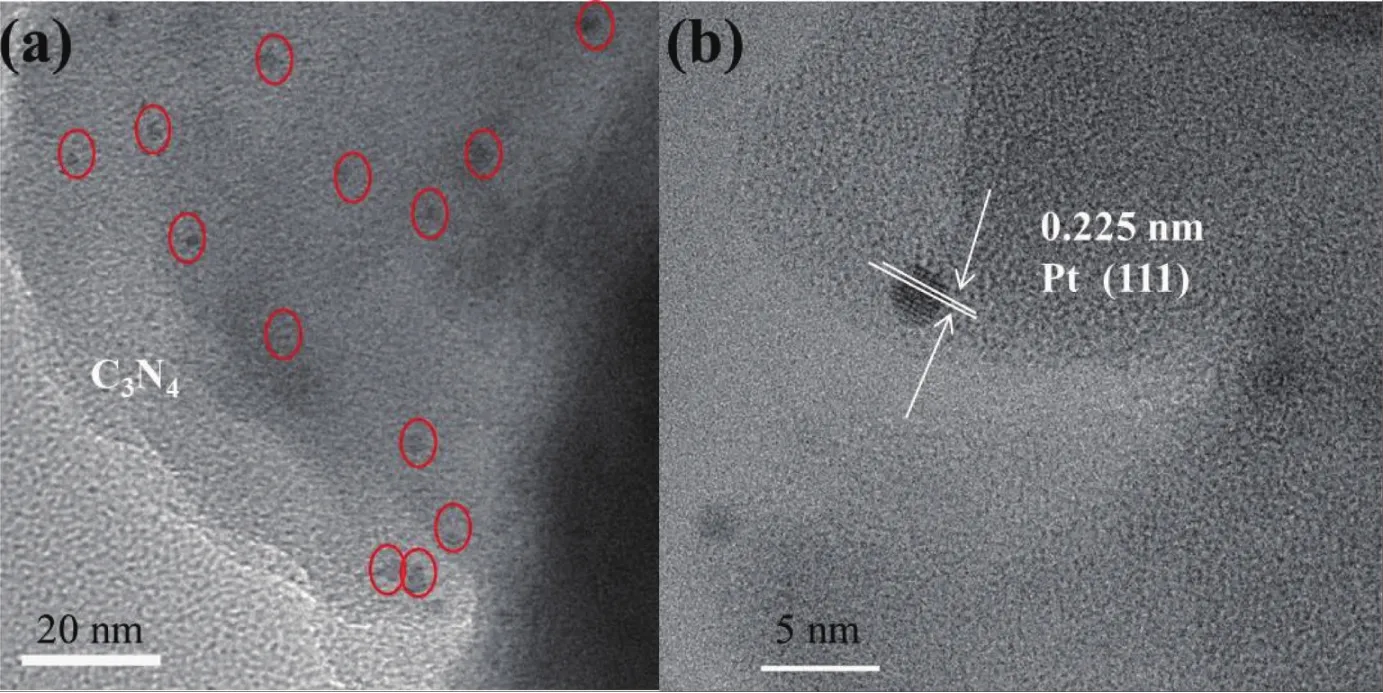
Fig.13 HRTEM images of Pt-1.60%MoO3-C3N4 sample
On the basis of previous analysis,the possible Z-scheme charge carrier transfer mechanism in photocatalysis was proposed as showed in Fig.14.Initially,under visible light irradiation,C3N4absorbs photons of energy for generate electrons and holes(Eq.1).At the same time,electrons and holes are generated on MoO3as it has suitable band gap to absorb visible light(Eq.2).Subsequently,the photogenerated electrons in the conduction band (CB)of C3N4are scavenged by adsorbed oxygen to form superoxide radicals(·O2-)(Eq.3).The surface adsorbed MO molecules can capture the short-lived superoxide radicals to initiate MO degradation (Eq.4).On the other hand,the electrons in the CB of MoO3transfer to the photo excited holes(h+)of C3N4(Eq.5)and the h+in the VB of MoO3may be able to react with MO molecules(Eq.6).Finally,repeated attacks dyemolecules by h+in the VB of MoO3and·O2-lead to successful degradation of MO.
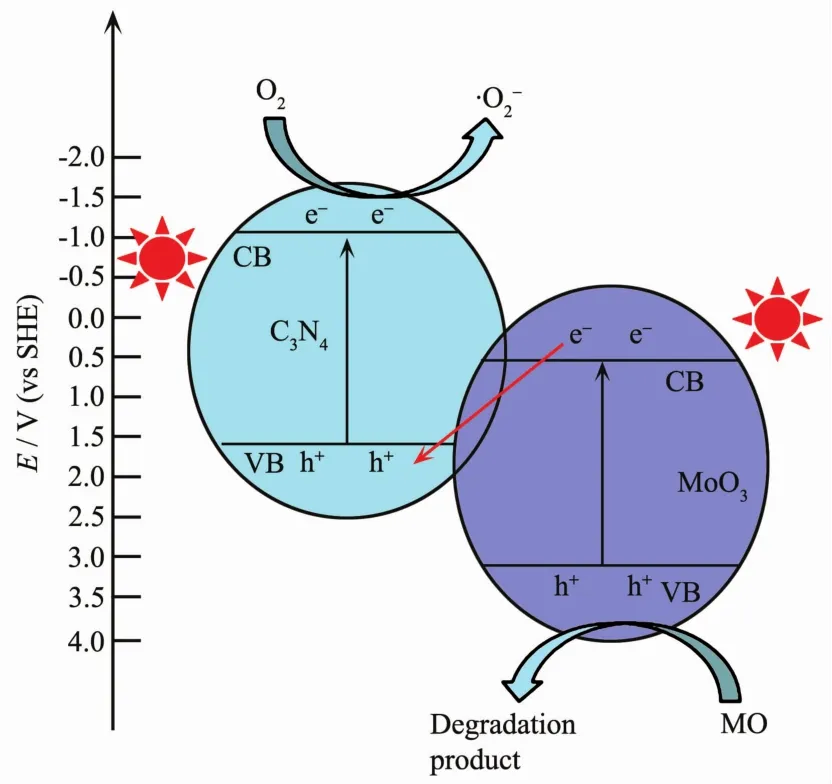
Fig.14 diagram of energy band structure and the possible photocatalytic mechanism of MoO3-C3N4

3 Conclusions
In summary,MoO3-C3N4photocatalysts prepared by impregnation method exhibited much higher visible-light catalytic activity than that of pure MoO3and C3N4.Particularly,when the content of MoO3is 1.60%,the MoO3-C3N4composite has biggest BET surface area and exhibited high catalytic activity in the degradation of MO under visible light irradiation.According to the photocatalytic results,the synergistic mechanism between C3N4and MoO3were proposed.A Z-scheme charge carrier transfer mechanism was confirmed for the photocatalytic reaction. The nanostructured layered MoO3-C3N4heterojunction is low costs,easy preparation and high catalytic activity under visible light radiation,and therefore,ready for application in other related areas,such as solar energy conversion,photovoltaic devices and large scale environmental application.
Acknow ledgements:This work is supported by the National Natural Science Foundation of China (Grant No.21403124)and NaturalScience Foundation ofShandong Province(GrantNo.ZR2014JL014).
